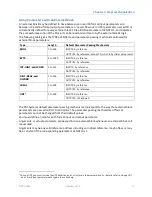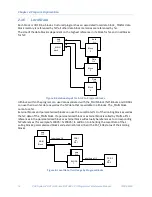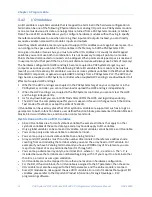
Chapter 2. Program Organization
28
PACSystems* RX7i, RX3i and RSTi-EP CPU Programmer's Reference Manual
GFK-2950C
2.3.5
Interrupt Block Scheduling
You can select one of two types of interrupt block scheduling at the target level:
▪
Normal block scheduling
allows you to associate a maximum of 64 I/O and Module Interrupts
and 16 Timed Interrupts. With normal block scheduling, all interrupt-triggered blocks have equal
priority. This is the default scheduling mode.
▪
Preemptive block scheduling
allows you to associate a maximum of 32 interrupt triggers. With
preemptive block scheduling, each trigger can be assigned a relative priority.
Normal Block Scheduling
Interrupt-driven logic has the highest priority of any user logic in the system. The execution of a block
triggered from an interrupt preempts the execution of the normal CPU sweep activities. Execution of
the normal CPU sweep activities is resumed after the interrupt-driven block execution completes.
If the CPU receives one or more interrupts while executing an interrupt block, it places the incoming
interrupts into the queue while it finishes executing the current interrupt block. Timed interrupt
driven blocks are queued ahead of I/O or Module driven blocks. I/O or Module interrupt driven blocks
are queued in the order in which the interrupts are received. If an interrupt driven block is already in
the queue, additional interrupts that occur for this block are ignored.
Preemptive Block Scheduling
Preemptive scheduling allows you to assign a priority to each interrupt trigger. The priority values
range from 1 to 16, with 1 being the highest. A single block can have multiple interrupts with
different priorities or the same priorities.
An incoming interrupt is handled according to its priority compared to that of the currently executing
block as follows:
▪
If an incoming interrupt has a higher priority than the interrupt associated with the block that is
currently executing, the currently executing block is stopped and put in the interrupt queue. The
block associated with the incoming interrupt begins executing.
▪
If an incoming interrupt has the same priority as the interrupt trigger associated with the block
that is currently executing, that block continues to execute and the incoming interrupt is placed
in the queue.
▪
If an incoming interrupt has a lower priority than the interrupt associated with the block that is
currently executing, the incoming interrupt is placed in the queue.
When the CPU completes the execution of an interrupt block, the block associated with the interrupt
trigger that has the highest priority in the queue begins execution
—
or resumes execution if the
block's execution was preempted by another interrupt block and was placed in the queue.
If multiple blocks in the queue have the same interrupt priority, their execution order is not
deterministic.
Note:
Certain functions, such as DOIO, BUS_RD, BUS_WRT, COMMREQ, SCAN_SET_IO, and some
SVC_REQs may cause a block to yield to another queued block that has the same priority
Summary of Contents for PACSystems RSTi-EP
Page 357: ......
Page 466: ...Chapter 9 Diagnostics GFK 2950C February 2018 451 ...
















































